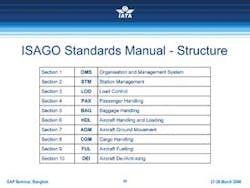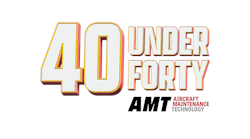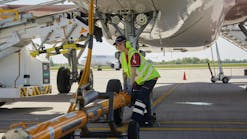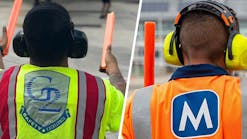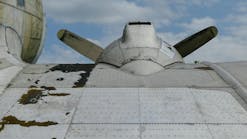By Mike O’Brien, director, implementation/auditing, safety, operations and infrastructure, IATA
Following the official launch of ISAGO at its Ops Forum event in late February in Madrid, the International Air Transport Association is now focused on finalizing all the practical aspects of getting this new global safety audit program up and running.
ISAGO is designed for ground handling companies operating at airports. Many players in the aviation industry have recognized that something needs to be done to “raise the bar” in terms of operational safety performance in ground handling. There are a good number of ground handling companies that are performing well. Our challenge is to achieve this level of performance throughout the industry.
Development of a common set of globally applicable operating standards, coupled with an audit program to assess conformity with those standards, seemed to be a logical solution to promote this more consistent safety performance level, and to better promote a risk management approach.
Safety is at the heart of the program, but there’s also huge efficiency gains to be made. Airlines expend enormous amounts of resources annually in carrying out ground service supplier audits at all their stations. And while it can be argued that such audits make good business sense, in many aviation regulatory environments (Europe being a good example), airlines are required to conduct such audits. Not only do the airlines execute the audits, but the ground service providers have to receive the audits and respond to them. With several thousand audits taking place each year, this is a poor use of valuable resources.
Modeled on IOSA
Having launched IATA’s Operational Safety Audit of airlines in 2003, we were keen to make use of that experience. We’ve now conducted more than 500 audits under IOSA, and we’ve learned a lot, especially on the need to ensure consistency and quality of auditor performance. Like IOSA, ISAGO will have an arrangement — closely controlled — whereby audit reports can be shared among interested parties. If you’re using a report of an audit that you haven’t conducted yourself, you’ll want to be sure that it’s been done right. That’s where the ISAGO quality processes really matter.
Program basics
At the heart of ISAGO is a standards manual, which has been developed by IATA with the support of many industry specialists from both airlines and ground service providers. There is a task force dedicated to collation and analysis of safety data related to ground accidents and incidents. Many parties are contributing data, most notably the International Aviation Handlers Association (IAHA), and the Flight Safety Foundation which has brought to bear the data it has acquired in its Ground Accident Prevention (GAP) program.
ISAGO standards are classified in 10 different categories (see box on page 44). Each audit will be tailored to the type of activity being undertaken by the ground service provider being audited.
For further efficiency in audit execution and follow-up, each audit will be configured on an electronic audit management platform, which enables each auditor to access not only the actual standards and checklists, but any additional guidance and reference material that might be needed. The lead auditor will then bring each of the elements together from all auditors into a final report. The same software platform is then used to manage the corrective-action phase of the audit, allowing both auditors and auditee to resolve findings via the Web. The electronic platform has worked well for us in IOSA. It promotes consistency, efficiency, security and ease of handling of audit reports.
Conducting the Audits
IATA has decided to carry out ISAGO audits using a pool of auditors — drawn from existing airline resources conducting such audits — to carry out audits at the airport station level. Unlike existing ground handling audit programs, ISAGO audits will be conducted also at the headquarters level. Here, a combination of resources will be used. Existing accredited IOSA Audit Organizations — with their particular skills in auditing organization and management systems, will be the basis of the headquarter-level audit. They will then be paired with airline resources in order to provide continuity with the station audits. Assembling and managing the ISAGO Auditor Pool will be undertaken by IATA, which already has a track record of managing pool audits with both the IATA Fuel Quality Pool (IFQP) and De/Anti-icing Quality Control Pool (DAQCP). This pool management experience will be valuable and the ISAGO Pool will bring its own nuances and complexity, most notably the sheer scale of the number of audits needed to be programmed. Ultimately, we see the potential not only to bring the management of these pool programs together, but to see how best to integrate the standards and the programs themselves with ISAGO.
Auditor Training
IATA’s Training and Development Institute conducts the core training component — the ISAGO Auditor Training Course. This course has been structured to take experienced ground auditors and familiarize them with the ISAGO principles, practices and standards. Having all ISAGO auditors working to a common standard and philosophy will be a great improvement in and of itself. The ISAGO Program Manual also lays down strict pre-requisites for ISAGO auditors, including not only successful completion of this training course, but also conducting initial audits under the supervision of an evaluator, before being released to “fly solo.”
Training for Ground Service Providers
Training for ground service providers on ISAGO generally, and on the standards themselves, is also available. Training dates that have been published to date are already filling up (see www.iata.org/itdi).
Trial Audits
Thirteen trial audits were conducted from late October 2007 to the end of January 2008. These trial audits were needed in order to assess the “auditability” of the standards that have been devised, how long an audit will last, how many auditors are required, and so on. The results from these trials are now being assimilated to identify any changes and improvements to be incorporated prior to the first real ISAGO audits in mid-2008. We had a great response from ground service providers volunteering both headquarters and airport stations to be audited, and we had great commitment from airlines contributing auditors to actually conduct the audits.
Regulatory and Airport Authorities
Unlike areas of higher focus, such as flight safety, there is comparatively little in the way of government regulation for ground handling activities. Traditionally, the responsibility for the safety oversight of ground handling companies has devolved to the airlines themselves, who are held accountable. Inconsistencies in approach and differences in regulatory regimes have resulted in much less safety improvement. It’s not surprising therefore that interest in ISAGO is coming from many regulators, and from ICAO itself.
The concept of industry-led audit programs delivering safety improvement opportunities that regulators can take advantage of has been pioneered in IOSA. At the 35th ICAO Assembly, in the Resolution on Safety Oversight, States were encouraged to make use of all available data, such as that from IOSA, in the execution of their safety oversight responsibilities. At the 2007 assembly, IATA positioned ISAGO as a program delivering similar opportunities for States. But it doesn’t take an ICAO Assembly for forward-thinking States to recognize a good idea and act on it. We’ve had great involvement and support from a number of key regulatory authorities from the start, and that support just keeps on growing.
Other authorities are gathering in support of ISAGO as well. Many airports have expressed interest in being involved in ISAGO, by building ISAGO requirements into their own operating regulations, and perhaps even requiring ground handling companies at their airports to go through the program. Airports Council International is represented on the ISAGO Project Coordination Group.
Program Launch
The team to run the ISAGO program is now assembling in Montreal, well in time to prepare for the first audits in mid-2008. As to how many audits might be conducted in 2008, IATA’s board has set a minimum target of eight headquarter audits and 60 station audits. But the program has the potential to go ‘exponential’ quite quickly. It will take just one or two of the bigger handling companies to say “Do all my stations,” and we could quickly run into large figures indeed. We will be geared up for much bigger audit numbers in 2009 and beyond. ISAGO audits will be conducted at two-year intervals at the headquarter level, and the same frequency has been set initially for the airport station audits, unless there is a conclusion that particular stations would need a more frequent audit. The production side of the house will need to stay focused to deliver, and we will need to ensure our quality assurance and quality control resources have sufficient capacity.
Getting the word out — free seminars
IATA plans to conduct a number of two-day regional information seminars in 2008 highlighting the benefits of ISAGO in an interactive workshop format. These seminars are intended to attract ground handling companies, airlines, airport authorities, regulatory authorities and any other interested parties. The seminars will be free of charge, but registration is required. The first seminar will be conducted in Kuala Lumpur on May 14 and 15. Full details of locations and dates can be obtained at www.iata.org/isago.
